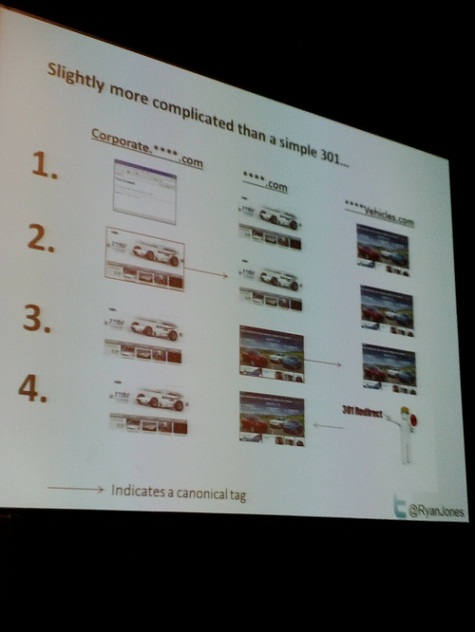 Ready for another one? I hope so. Up this time we have Jessica Bowman, Rhea Drysdale, Ryan Jones, Dana Lookadoo, and Shari Thurow. My wrists and forearms are on fire so no banter this time around, just signal.
Ready for another one? I hope so. Up this time we have Jessica Bowman, Rhea Drysdale, Ryan Jones, Dana Lookadoo, and Shari Thurow. My wrists and forearms are on fire so no banter this time around, just signal.
Up first is Dana Lookadoo.
Dana takes the podium and immediately starts rapping the name of her company – Yo! Yo! SEO! So, I mean, there’s that right off the bat. Let’s see what else she has in store for us.
Avoiding Migration Fallout
Search engine optimization throughout the site migration process CAN result in little to no loss in rankings and traffic, improved impressions and CTR, and minimal fallout.
Let’s play a game!
Imagine that you’re an SEO. You get the client announcement that they’ll be migrating their site in 3 weeks. Most of the site is in Drupal. And it’s broken. And there’s no content. And they don’t want to see any loss in ranking. You begin to explain everything that needs to happen and what they can expect. Your client then says they “had no idea it would be this involved”. And she’s 9 months pregnant. And having the baby tomorrow.
No, this isn’t a hypothetical situation. This is what @netmeg dealt with this last week.
Dana says it’s all about planning. Either you plan the details of your site OR you lose rankings, traffic and kill kittens. No one wants to kill kittens.
SEO Website Migration Stages
- Discovery & Data Collection
- Planning & Implementation
- Launch & Clean Up
- Discovery & Data Collection
Discovery & Data Collection
Migration Variables
What’s going to change?
- Design
- URLs
- IA structure
- Content and Meta
- Plugins and functionality
To Design Or Not To Design
- Mirror the content order
- Keep home page links
- Retain link structure
Dana recommends holding off on your redesign for 1-2 months after migration. New everything to search engines will kill kittens. Again, please think of the kittens.
Know Thy Internal Links
- Maintain link juice to key pages by preserving navigation, footers, and home page links.
Know Thy Top Pages
- Which pages have the most links? Use Google Webmaster Tools and Open Site Explorer to help you.
Weekly Baseline Metrics
Look at your pages that are index, your cache date, home page authority, your domain authority, your Google Webmaster Tool errors. Think about what you want to track on a monthly basis. This is when you’re really getting into Excel and keeping track of everything. Chart out organic traffic to measure pre and post relaunch visibility. Measure impact on social. Chart out LinkedIn, Facebook, Twitter, Google+.
Planning & Implentation: Auditing content, mapping keywords, running redirects.
Put the Dev Site Into Protective Custody
- robots.txt – disallow
- Password-protect the staging site to protect your baby
Content Audit
- What kinds of content do you have? What’s going to move? Rate your pages – are they redundant, outdated, trivial? Which ones need a prominent link focus? What’s indexed?
IIS SEO Toolkit – Content Types
- Identify types of content on the old site, looking at text, images, PDFs, etc. Export all your URLs from IIS SEO Toolkit to get a CSV scrape of the site to build a content audit.
- Keyword Research
- Redesign?
- New URLs?
- Revised IA?
- Strategize and map those keywords
Redirect 1 to 1
- Say NO to side-wide redirects
- Map page to page and retain site hierarchy and structure. If you have a large or ecommerce site you can set up automation rules.
Launch and Clean up
- Try to break the site – broken links, multiple browsers
- New Domain? Keep both active
- 503
- Mail server
- Secure login areas?
Launch
You can expect a drop in rankings fro 2-4 weeks after relaunch. Make sure you’ve set expectations in your team.
Post-Launch Cleanup
- Remove the robots.txt disallow
- update/submit your XML sitemap
- If a new domain, add and verify your site in Google Webmaster Tools
- Fill out a change of address in Webmaster Tools for a domain switch
- Beware of errors, esp your 404 index errors
Next up is Jessica.
How to get everyone on the SEO bandwagon
The typical lifecycle of a project looks like this:
- Project inception
- Requirement gathering
- design
- development
- QA testing
- Live on site
The problem is SEOs aren’t usually brought in until the later stages. That what’s we want to change.
Getting It Right With Requirements
This is a big miss by a lot of SEOs. Make sure you sit in on these meetings. This is where inhouse SEOs miss the mark. They don’t go to the meetings and they miss hearing about a few things that can totally screw over SEO. You must attend all requirements meetings. Just figure out how to open up your schedule. Cannot tie SEO needs to enough project requirements because they do not know the project requirements.
You have to READ all the documentation.
Reality is that few SEOs:
- Have experience writing technical requirements for SEO
- Do not know how to define complete SEO requirements
- Read and contribute to all project documentation
Jessica shows some classic examples of people who just weren’t thinking about SEO that day when they were setting requirements.
Getting It Right With Designs
When we talk about designs we need to sit down with the design team and have a “jam session”. Work with them before they ever open up Photoshop
Challenge:
- SEO is not top of mind
- Designers do not understand SEO
- This is the designer’s one shot to do something new and innovative
- They are evaluated on their design
- Designers get married to their designs
Telling a design to “make something search engine friendly” is not a good idea. You need to really explain what that means for them. SEO and design teams need to come to an aggreement BEFORE presenting designs to the team. Learning accrues over time. The more you train, the more someone is going to learn.
Next up is Rhea.
The most important thing to think about when migrating a site, to her, is links. You want to keep your links.
Link Discovery Tools
- Bing’s Webmaster Central: They have some great tools. You can see all the crawl errors. She likes the error report. It will help you identify links that you can 301 or lets you know you need to republish a page. Bing will also give you the anchor text associated with the links.
- Google Webmaster Tools also allows you to do this.
- Open Site Explorer: If your site isn’t verified you can also use OSE or Majestic SEO.
- Google Analytics: See who’s sending you traffic
- 404 Discovery: Check within Webmaster Central. Maybe you used to have a page or something needs to be 301’d. You can also go the source
Edit What You Can
- Domains You Own
- Subdomains
- Self-published links
- Sites with a direct relationship
- Paid links
What Don’t You Control
- Old content
- Curated lists
- Reviews
- News/media mentions
- Site-wide links, blogrolls
- Social Shares
Prioritize Based On
- Link count (eg site-wide vs single link)
- Followed vs non-followed
- Anchor text
- Domain and page authority
Automate & Outsource
- Use something like Mechanical Turk or Odesk.
Outreach
- Create and send your request: Make sure new links still adds value. Be fast, specific and appreciative.
Track & Follow Up
- Don’t take it personal if people don’t respond to you quickly. Put it in a calendar, wait a week, respond to them again. Send them another reminder in two weeks.
- Use Raven for link monitoring. You can put in the link and do link monitoring and it will auto-discover the link when it goes live.
Replace What You Can’t Change
Create your checklist
- Number of backlinks
- Their value
- Anchor text they had
Next up is Ryan Jones.
A site migration doesn’t always have to be your worst nightmare. Sometimes you have happy or totally legit reasons to move.
Reasons To Move Domain
- Changing your brand identity
- You bought a different site
- You buy a site that was more links than yours does
- Google penalty
- You really screwed up
- Consolidate/leverage authority
Ryan had a killer case study about a major car brand all prepared for us… but then he switched jobs (going to a competitor) and he’s not allowed to say the name of his previous employer or give us any of the real numbers. So everything below is pretty anonymized.
Original Domain Landscape
Ryan’s old employer was using their brand.com site as an investor site. Then they had brandcredit.com, brandowner.com, brandparts.com, etc.
They wanted to have one brand, one domain because they had a theory that their site wasn’t meeting user expectations. Visitors wanted car information on the brand.com site, not company information. The proposed solution was to consolidate all the different sites to consolidate and leverage the authority.
The next step was a massive internal sales effort.
Current Domain Landscape
Create one authority site and allow other divisions to leverage that authority.
It’s a Double Move
Requirements:
- Move 2 sites at once.
- Ensure no down time. Mitigate short period of duplic content. Necessary due to Akami, testing, QA, etc.
Selling It
Step 1: What’s In It For Me
- Promised xx% increase in monetized site value
- Communicate value and get all teams on board
Step 2: Come up with a plan
- How to actually move 2 sites
- How to allow for testing and QA
- Revert back if things go horribly wrong
- Communicate plan
Steps 3: Measure Everything
- Rankings
- Traffic/Value/Bounce Rate/404s
Slightly more complicated than a simple 301 redirect

How Did It Turn Out?
- Move Traffic: More than 28 percent increase in total traffic
- Better Engagement: Bounce rate decreased by 2 percent
- Value: Value per visit up over 8 percent. Overall site value up over 38 percent.
- Visibility: Pagerank and ranking increases
Shari Thurow also presented but she prefers not to be liveblogged. So we respect that.
Read the rest of our SMX West 2012 liveblogging coverage for more insight.


